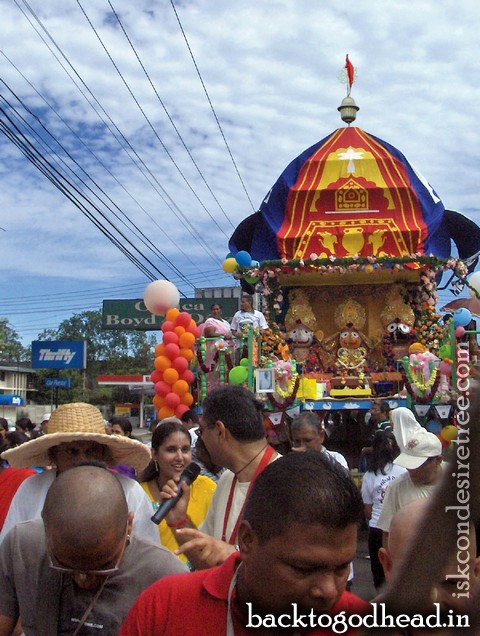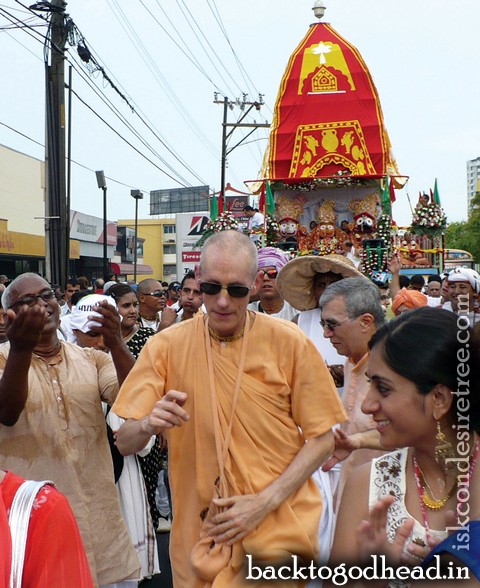
I’m always intrigued at how things manifest from a seed of desire into 3D. ISKCON’s history includes many amazing stories of how Srila Prabhupada’s disciples responded when he asked them to do things they’d never done before: By his desire and their desire to please him they built temples, published books, and put on huge outdoor festivals.
Since Prabhupada’s departure, devotees all over the world have continued to conceive and execute devotional projects to serve his mission. The saying “Man proposes, God disposes” is as true today as when Prabhupada was physically present with us.
Recently our neighbor and friend Vatsala Dasa went to Panama to help a small group of dedicated devotees put on a Rathayatra festival. Prabhupada wanted Jagannatha Puri’s ancient chariot festival reenacted in cities all over the world. During the Puri festival, the deities (Jagannatha, Baladeva, and Subhadra) are brought out from the temple into the public, where everyone can see them. Unlike the Puri temple, ISKCON temples bar no one from entering. Yet owing to a lack of interest in spiritual life, many people never go to a temple. So the Lord, being infinitely merciful, goes out to capture people’s unsuspecting hearts. He leaves His pristine temple to ascend a chariot and ride through crowded and dirty city streets to benefit all who see Him.
By seeing the deity form of the Lord, even an atheist can become a devotee. Such is the materialist’s unimaginable good fortune in seeing the deity. So if the foolish materialist won’t come to see the Lord in the temple, the Lord will appear before them outside.
In Panama, five young couples raised well over $20,000, built a Rathayatra chariot, got the permits, and organized a large festival for the past three years. How did they do it? On Vatsala’s visit to Panama City last summer for the third annual Rathayatra, he interviewed the families who made it all happen. What follows here has been drawn from those interviews.
A Song of Inspiration In the year 2000, the Panama City devotees brought the itinerant preacher Nirantara Dasa from Los Angeles to Panama. Nirantara writes catchy Krishna conscious lyrics for melodies from popular songs. While entertaining the devotees in Panama, he sang one of his songs “Festival of the Chariots” and added a few words about Lord Jagannatha rolling through the streets of Panama in the future. This word picture struck deep into the hearts of devotees like Syama Candra Dasa and his wife, Radha Govinda Dasi. “Yes, why not?” was their internal response to those prophetic words.
Two years later a group of devotees in Panama met to discuss plans to go to the Los Angeles Rathayatra. After considering the cost, one of them suggested they use the money to have their own Rathayatra. The idea caught hold, and Syama Candra began spearheading elaborate plans for Panama City’s first Rathayatra. While visiting Jagannatha Puri, Syama Candra placed an order for deities of Jagannatha, Baladeva, and Subhadra. They were to be carved and sent to Panama. But as the date for the festival neared, the deities had not arrived. Praying to the Lord for direction, the devotees hired a local artisan to carve the deities.
Other devotees caught the wave of enthusiasm and joined to help bring Lord Jagannatha to the streets of Panama City. Caturmurti Dasa and his wife, Sarva Mangala Dasi, had come to Panama from India for jobs. Caturmurti was fascinated with gadgetry and found his propensity could be dovetailed in Krishna’s service by taking charge of the lighting and sound for the festival. He is also responsible for getting all the necessary permits. His sincere devotion has had a contagious effect on others, especially his older brother, who at first vehemently opposed his involvement in Krishna consciousness. Now his brother gives generous donations toward the festival and helps him obtain the permits.
Manish Manik and his wife, Ritika, having moved from Bombay, were attracted to the devotees in Panama. Despite being raised in a family that worshiped Lord Shiva and Durga, Manish had a natural attraction for serving Lord Krishna. He helped the devotees organize the Rathayatra festival by doing whatever was needed and taking charge of lifting and lowering the chariot’s canopy numerous times on the parade route. He humbly submitted that by this service he was falling in love with Lord Jagannatha. That is the goal of everything the devotee does. It is the perfection of our lives to feel love in our heart for the supreme lovable object.

Srilesh Sridharam and his wife, Petrina, also came to Panama from India for jobs. Srilesh lived most of his life in Calcutta. He met his wife in the fourth grade, and by grade six the two knew they wanted to be married someday. Although this was not the usual arranged marriage, the parents on both sides were supportive of the union. Srilesh was one of the only devotees in the organizational group who had ever seen a Rathayatra. The procession had passed by his house in Calcutta, making him a recipient of the Lord’s causeless mercy. He accepted the role of construction foreman for building the chariot.
Constructing the chariot proved to be particularly challenging, especially the first year. Having never built a chariot, Caturmurti hired local craftsmen. But the recruited workers often failed to show, and when they did it was much later than the time agreed upon. A developing country with limited resources and a siesta work ethic made progress slow.
Jeetendra Sippy and his wife, Vinita, are the final couple making up the organizational team. When Jeetu, as his friends affectionately call him, met the devotees, he was inspired by their service. He prayed to the Lord, “Please accept my service.” Shortly thereafter the Rathayatra crew invited him to join their committee. He agreed at once, confident that the invitation was the answer to his prayer. Jeetu has become a vital part of the team, doing what’s needed, including acting as the treasurer and keeping track of the thousands of dollars required to put on the festival.
The Chariot Sits
When the chariot finally made its debut for the first Rathayatra, it didn’t work. Thinking that Lord Jagannatha hadn’t accepted his service, Srilesh started to cry, as did the engineer he’d hired. But the Lord seemed to hear their heartfelt lamentations, and the devotees were able to get the chariot to move. Despite having no brakes and no steering, the chariot carrying the Lord of the universe, along with His sister and brother, made it safely to its destination.
The second year, the police escort and the canopy arrived two hours late. And again the chariot wouldn’t budge. Everyone was trying to analyze and fix the problem. This time Vatsala was there, and his experience with Rathayatra chariots enabled him to diagnose the problem. Detecting a bent front axle, he made the necessary adjustments to set the cart on its journey four hours behind schedule. Nevertheless, about nine hundred participants joined the joyful festival.
Besides the mechanical difficulties, the five couples organizing the festival were faced with the challenges of working together as a cohesive unit. Differing personality styles, life experiences, and opinions about how things should be done created tense interactions within the team. But they all agreed on one thing that working together to spread Krishna consciousness would purify their hearts and please their guru (Guru Prasada Swami), Srila Prabhupada, and Krishna.
From the Vedic literature we hear of the great cosmic event in which the demigods and demons churned the ocean of milk to produce immortal nectar. Before the nectar appeared, however, the great effort of churning yielded only poison. In a similar way, our service endeavors often bring our impurities to the surface. We can also compare this to making ghee from butter. When butter is heated, all the “impurities” rise to the top and can be scraped off, leaving clarified butter, or pure ghee. Because of the sincerity of the group, they continued to work out their differences, and things began to go much smoother.
Women at Work
The services of the women in the organizational group are also integral to the festival’s success. Radha Govinda Dasi organizes the chariot’s decorations and the dressing of the deities. The women also make prasadam to distribute at the festival. All the women enjoy hosting guests who come from all over the world to help with the event. Vatsala attests to the unparalleled hospitality they provide to all the guests by creating a welcoming and nurturing environment. They eagerly look forward to this highlight of the year, and their enthusiasm inspires others to take part in the adventure of organizing and putting on the Lord’s festival.
As a bonus for the devotees’ hard labors, Krishna increased their service opportunities when the Rathayatra cart carrying Lord Jagannatha became part of a large Christmas parade in Panama City. Thousands of spectators lined the streets. The devotees distributed large quantities of cookies and flowers to the eager crowd. Lord Jagannatha and the devotees received favorable television coverage as well.
Vatsala Dasa has now taken part in three of Panama City’s Rathayatras. He wanted to share this story with the international community of devotees, hoping others around the world would be inspired by the example of these five couples all working full time and raising families. Sometimes we don’t believe it is possible to do any significant service while in the throes of family life. But with a vision and strong desire and the mercy of the Lord a blind man can see the stars, a dumb man can recite poetry, and a lame man can cross mountains.
Arcana Siddhi Devi Dasi was initiated by Srila Prabhupada in 1976. She lives with her husband and son in Sandy Ridge, North Carolina, USA, where she works as a psychotherapist in private practice.
Devotees who feel inspired to take part in festivals in Panama can contact Vatsala Dasa at vatsal@hughes. net.
